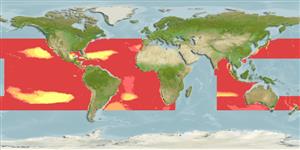Preferred temperature (Ref.
123201): 4.1 - 7.9, mean 6.1 °C (based on 492 cells).
Índice de diversidade filogenética (Ref.
82804): PD
50 = 0.5312 [Uniqueness, from 0.5 = low to 2.0 = high].
Bayesian length-weight: a=0.01995 (0.00906 - 0.04395), b=3.01 (2.83 - 3.19), in cm total length, based on all LWR estimates for this body shape (Ref.
93245).
Nível Trófico (Ref.
69278): 3.8 ±0.5 se; based on size and trophs of closest relatives
Resiliência (Ref.
120179): médio(a), tempo mínimo de duplicação da população 1,4 - 4,4 anos (Preliminary K or Fecundity.).
Fishing Vulnerability (Ref.
59153): Low vulnerability (10 of 100).
Nutrients (Ref.
124155): Calcium = 53.2 [17.1, 134.8] mg/100g; Iron = 0.442 [0.179, 1.356] mg/100g; Protein = 18.3 [15.5, 21.5] %; Omega3 = 0.207 [0.058, 0.720] g/100g; Selenium = 12.4 [3.5, 38.1] μg/100g; VitaminA = 57.2 [6.2, 532.1] μg/100g; Zinc = 0.531 [0.255, 1.102] mg/100g (wet weight);
